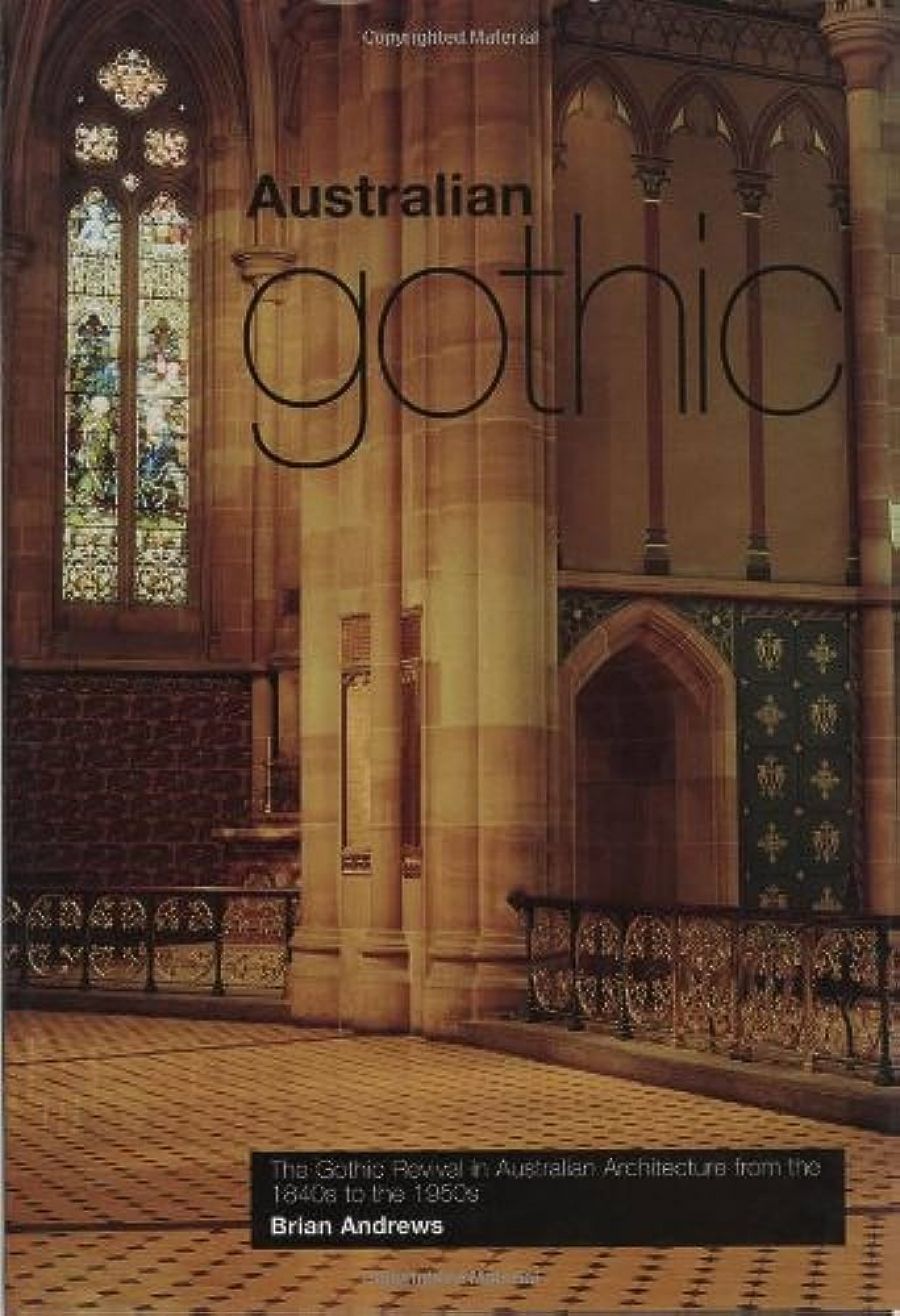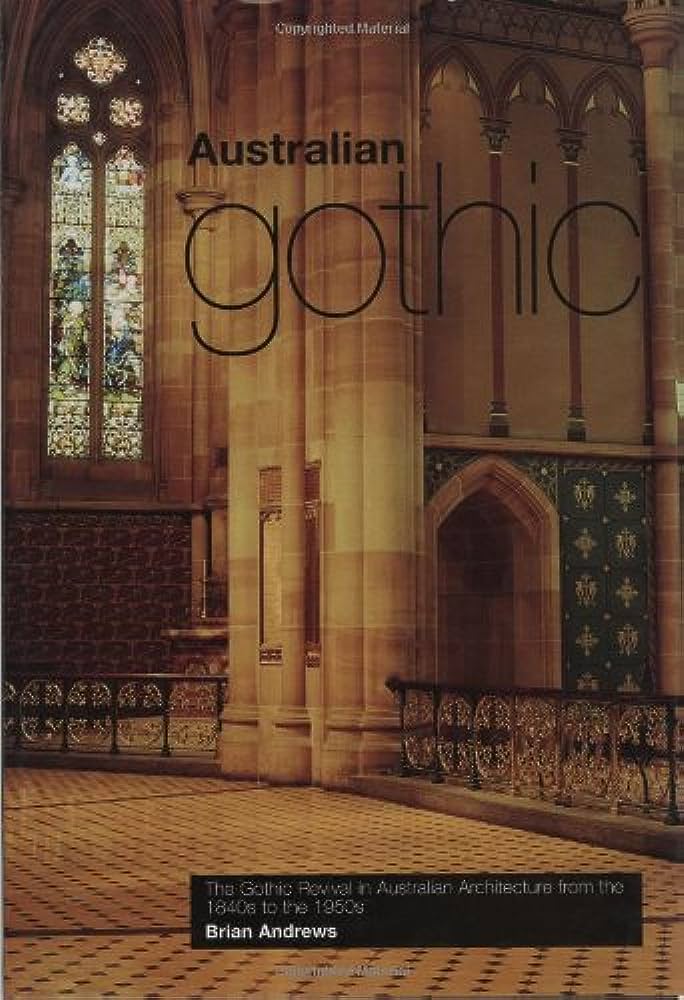
- Free Article: No
- Contents Category: Architecture
- Review Article: Yes
- Article Title: The Definitive Gothic
- Online Only: No
- Custom Highlight Text:
A major work in the history of Australian architecture is a rare thing, and it is the more remarkable when the author is an amateur – in the true sense, that is – an enthusiast and connoisseur rather than a professional or academic hack. For Brian Andrews, though he has developed his expertise during a full-time career in telecommunications, is certainly not an amateur in terms of expertise.
- Book 1 Title: Australian Gothic
- Book 1 Subtitle: the Gothic revival in Australian architecture from the 1840s to the 1950s
- Book 1 Biblio: Miegunyah Press, $89.95 hb, 214 pp
- Book 1 Cover Small (400 x 600):

- Book 1 Cover (800 x 1200):

Even as a study of churches, the book has its own idiosyncrasies. Andrews avoids a chronological treatment and presents instead essays on the themes of association, provincialism, patronage, the impact of Continental Europe, and the existence (or otherwise) of an Australian Gothic style. It must be said that this approach is not wholly successful. Inevitably, most architects tend to be bundled into one chapter or another. Walter Butler, a pioneer in the use of Australiana motifs, is summarily treated in the chapter on provincialism, whilst the in many ways comparable Alexander North (rightly) dominates the chapter on the Australian Gothic, at the other end of the book.
There are dizzying leaps back and forth in chronology, not only between the chapters but within them. Indeed, it is one thing to avoid mechanical chronology, but another to ignore the realities of historical precedence. Andrews refers to R. G. Suter’s exposed frame churches in Queensland from 1866 onwards as ‘pioneering’, which seems unreasonable given that Christ Church Tarraville, Victoria, was a more elegant work of more than a decade earlier (and he compounds the slight by describing the latter as ‘drop-slab’). The whole issue deserves much more consideration; as long ago as 1981 the present writer, in the Heritage of Australia, pointed the connection between the Ecclesiologists, the Selwyn churches of New Zealand, the church at Tarraville, and what was to become the vernacular Queensland exposed frame.
It is impossible to give an account of all the new information that Andrews has unearthed, especially in relation to Tasmania. For example, St Paul’s, Oatlands, was traditionally attributed to the local draftsman and builder Frederick Thomas, but has always seemed irresistibly Puginian in character. Andrews now produces the evidence that it was a Pugin design. An interesting sidelight, not mentioned by Andrews, is that Thomas’s great-great-granddaughter has some grounds for believing that Thomas was Auguste Pugin’s illegitimate son, and A.W.N. Pugin’s half-brother.
Andrews is of course full bottle on his own special topics, notably the Hansom Brothers and W.B. Tappin, and generally on matters South Australian, but he sometimes falters on other subjects. He seems to attribute more importance to Henry Bastow’s one venture into South Australia than to his whole oeuvre in Victoria, and makes no reference to Bastow’s sources in the work of Reed & Barnes. In fact, one of the book’s chronological aberrations is the fact that we first hear of Reed & Barnes long after Bastow. Moreover, in dealing with Reed & Barnes, he makes no reference to Edward La Trobe Bateman, even when referring to the quintessentially Batemanesque Clement Hodgkinson house in East Melbourne.
Henry Hunter’s ‘Invercoe’ at Battery Point, Hobart, is mentioned, but not his more interesting ‘Rouseville’ (later ‘Bellona’) in Davey Street, an almost direct take from Paull & Ayliffe’s ‘The Sycamores’ near Manchester, as published in Villa and Cottage Architecture of 1868 (the same design was copied in Victoria by Lloyd Tayler). The style of the original was referred to as ‘modernized domestic-Gothic, of the English variety’, but such terms are not even mentioned by Andrews, and he might have been wiser to eschew the domestic field entirely rather than make such brief and arbitrary forays into it. One can readily understand that his real interest is the true Gothic Revival of the Ecclesiologists and Pugin, but that is no defence when he elects to venture into much broader pastures, discussing even Scottish Baronial/American Romanesque post offices.
The influence of Viollet-le-Duc’s Dictionnaire is acknowledged, if grudgingly, by reference to copies held by the Adelaide sculptor William Maxwell, and the Geelong architect George Henderson. But it goes well beyond that, for hints of Viollet in the works of other architects are numerous, though perhaps more in secular than ecclesiastical work. Sir George Verdon, Honorary President of the Victorian Institute of Architects, held a copy with which he seems to have battered the reluctant head of his architect W.W. Wardell. The counter design in Wardell’s E.S. & A. Bank in Melbourne is directly taken from Viollet. The bank’s Venetian windows, derived from those of the Doge’s Palace and inserted at Verdon’s insistence, are almost certainly from volume two of Viollet’s Entretiens (the English translation of which had just been published in 1881) rather than being the result of Wardell’s travels, as surmised by Andrews. Most intriguing of all are the Violletic details of ‘Rodborough Vale’, Victorian country property of the Bucknall family – that is, the relations of Pugin’s English translator.
There are some aspects that will irritate, though not inconvenience, the reader, but whether they are to be blamed upon the author or the publisher is unclear. It is irritating to find pomposities like ‘residences’ for houses; possessives like Thomas’s and Dods’s given as Thomas’ and Dods’, as if they were plurals; capitals for common words like ‘Receiving House’, ‘Cottage Ornée’, ‘Plate’ and ‘Figure’, and ‘interpretive’ for interpretative (would the corresponding noun be interpretion?).
In general, Andrews is not well served by his publishers. The design of the book has a dated air, and is worryingly reminiscent of far less reputable works like Boland’s St Patrick’s Cathedral. The page numbers are irritatingly placed in the side margin, many of the otherwise valuable colour illustrations have a strong orange tinge, and there are jarring conjunctions of illustrations centred on the page with others bled to the edge. The notes are at the end rather than on the relevant page: whilst Miegunyah/MUP are not alone in following this irritating practice, one might expect a scholarly press to seize the opportunities offered by computerised layout, and pay some regard to the convenience and enjoyment of the reader.
Overall, this work is one of enormous importance and great interest, and it will remain the definitive survey of ecclesiastical Gothic architecture in Australia for the foreseeable future. In relation to the secular Gothic, one hopes that it may stimulate surveys of comparable reach by other scholars.

Comments powered by CComment